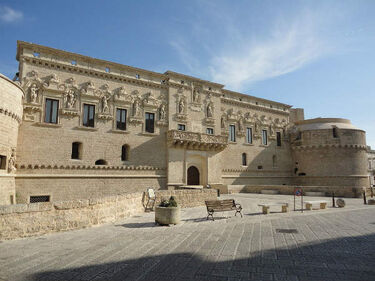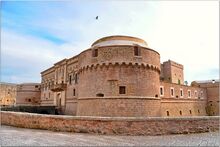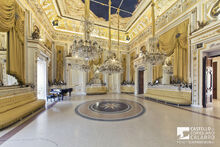| Ducal Castle of Corilian | |
|---|---|
 | |
|
Period |
XII - XVII century |
|
Location |
Corilian, Duchy of the Shraman Isles, NT |
|
Founder |
Dominic de Grisson |
The Ducal Castle of Corilian is one of the most prominent fortifications of the whole Duchy of the Shraman Isles and official see of the Ducal House Taher.
Like many of the fortifications and castles of the isles, its origins lie both in the need of a strong defense of the settlements from piracy, a plague which infested the Shraman Sea for centuries, and local wars, and in the necessity of the local lords to make a demonstration of power and prestige to impress the local populace and other lords as well.
From early mentions to the XIV century[]
The first mention of the castle is found in a charter dating to the XII century, where Dominic de Grisson, Antanaresian of Arveyran origins and adventurer who established himself as lord of the borough of Corilian few years before, declares that he had built a fortified tower "to protect the people and their substances in the borough of Corilian". No details are given about the exact nature of the fortified tower, nor about the materials used to build it.
In 1235, in the wake of a general surge of naval activities promoted by the Ajanic principalities of the coast, Corilian was conquered by Mahmoud Athal, a naval commander and prominent noble of Alleskan (today Alleskandberg), who established his rule upon most of the archipelago. The last years of the century saw an increase of conflicts between Alleskan and many Antanaresian lords for the control of the islands, and Corilian was often at the centre of the military operations. The castle and its borough were burnt at least in two occasions: in 1287 by an Antanaresian fleet, and in 1301 by Firush Athal (grand-niece of Mahmoud), in an attempt to recreate the old power of his ancestor.
Corilian and its island were finally occupied by Francesco degli Ubaldi, a noble of the Antanaresian city of Sessadraina, who styled himself as Count of Corilian, in 1312. He was not alone, however: in that period the whole archipelago was submitted by a series of nobles and adventurers coming from Sessadraina and other maritime cities of Antanares, who soon established an hereditary feudality which lasted until the XVII century.
The Antanaresian period (XIV - XVI century)[]
Mentions of the castle substantially increase from this period onward. The same Count Francesco himself, in a charter released three years after his establishment in Corilian, declares that he found the castle, at his arrival, "neglected and in such a state of despair" to need urgent repairs and works of consolidation.
He undertook such works for ten years, with the aim of transforming the old fortification in a true stronghold for his power and to improve the protection of Corilian. Thus, he built a new curtain wall, reinforced by poligonal towers; he also demolished many parts of the ruined tower erected by de Grisson, transforming it in a formidable rampart at the south-western corner of the fortification.
Further works were made by his nephew, Francesco II (1359-1370), who surrounded the external walls with the moat visible today, and further reinforced the perimeter towers. The new fortification proved its value when Ajanic pirates from Alleskan attacked it in 1371: the castle did not yield, saving the population of Corilian and its garrison from mass enslavement. Another prove came in 1383, when Corilian was attacked by another Antanaresian lord, Dominic IV de Feroni, in an attempt to overthrow the young count Guido II (1380-1394).
The reign of Count Guido III (1395 - 1411) marked a period of renewed prosperity and power for Corilian, and this was reflected also on the castle: the count decided to transfer his residence in the fortification, beginning the process which will transform it in an elegant residence (without loosing its original role as a military stronghold). It was the count to build the central corp which will then become the ducal residence.
The XV century saw a series of intensive works to be undertaken: Francesco III adapted the fortress to the new military challenges, building the first circular towers in 1425. However, this was not sufficient to save the castle and the Corilian lordship from conquest by an Ajanic fleet commanded by Arash Ziyar, visir of Kalihaan Jahan Shah, in 1434, in the wake of renewed expansion by the Tarajani Shahdom. Corilian thus became the centre of a new Ajanic administration of the archipelago (only few strongholds remained in possession of Antanaresian lords) for the rest of the century. However, this new Ajanic period left few traces of its passage upon the castle, which was constantly kept ready to resist incursions (especially in the second-half of the century, when Antanaresian aggressions were renewed) but not substantially modified.
In 1501, few years after the Antanaresian conquest of Alleskan and before the foundation of the Grand Duchy of Bakran, Corilian finally fell once again in the hands of an Antanaresian lord from Sessadraina, Alessio I Guinigi.

One of the two strong towers restructured by Alessio II Guinigi in the XVI century.
It was the beginning of a new era of prosperity for Corilian and whole archipelago: under the Guinigi family, the city became the true centre of power of the Shraman Isles. Alessio I and his son, Alessio II, managed to extend their direct overlordship and influence all over the other small lords (mainly Antanaresians) of the islands. In 1534, Alessio II also undertook works of extensive maintenance to the castle, restructuring the big circular towers, to better fit them for the new challenges of military techniques. Three years later, he bestowed upon himself the title of Grand Count, as a symbol of his power over the islands, and for the occasion he rebuilt the façade of the residential wing, together with a new hall where to receive dignitaries.
The second half of the century, however, marked a new period of decline in the fortunes of the Grand Counts of House Guinigi: Alessio III (1546-1565) temporarily lost control of the western part of the archipelago in favor of the Sessadraina Republic (which wished to extend direct control upon the archipelago). In 1567, when Francesco Antonio Guinigi, son of Alessio, was still a boy of seven, the forces from Sessadraina took Corilian itself: the castle was sacked by the forces of the Republic, which soon after established the city as the new seat of their Governor.
The Sessadrainan Period (XVI - XVII century)[]
Although most of the outer islands retained their independence, the foothold established by the Republic in Corilian proved to be stronger than imagined at first. The end of the XVI century and the following one were thus marked by the continuous attempts of the Governors at Corilian to make the other feudal lords accept the authority of Sessadraina. As a result, the period was conditioned by a state of almost constant war, and Corilian and its castle suffered the consequences of the conflicts: the castle was taken three times (1590; 1603; 1643), while raids from the fleets of different lords created a state of permanent insecurity which disrupted the economic bases of Corilian. The energies of the Governors in this period were all devoted to the strengthening of the fortifications of Corilian and the surrounding country.
The Tarajani Lordship[]
The constant wars between the Governors and the feudal lords sensibly weakened the defenses of the islands, disrupting their economy and capabilities. At the end this eased the final conquest of the archipelago by the new Kingdom born on the continent: the Tarajani Kingdom ended the XVII century emerging as a relatively-unified body, independent from Antanaresian influence, under the rule of "three Sigismunds" (Sigismund IV, Sigismund V, and Sigismund VI). With Heinrich V, the Kingdom expanded its borders. The first victim was, indeed, the Shraman islands: in 1670 a Tarajani fleet conquered Misrah, the easternmost island. Two years later, a Sessadrainan fleet was defeated by a Tarajani one in the waters outside Corilian (Battle of Corilian (1672)). Although the days of the rule of the Republic on the islands were counted, it was only under Heinrich VI (1677-1698) that Corilian was occupied by the Kingdom (1678).
For few years, the archipelago was ruled by a Royal Governor, until 1685, when the King resumed the old title of Count of Corilian, bestowing it to Hermann Van Renesse.
House Van Renesse ruled the Shraman Islands as Counts and then Dukes (1717) until 1951, when the last female heir of the House, Ariel, married Ahmad Taher, transferring the title to House Taher, which still holds it nowadays.

The Music Hall of the castle, built by Godfried Van Renesse in 1754.
The rule of House Van Renesse was a prosperous one, especially for the castle: although it retained its military functions (at least officially), the following period of peace enabled the Dukes to focus on the building of a true noble residence: the façade was finally completed, and the interiors were completely redone.